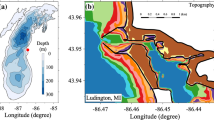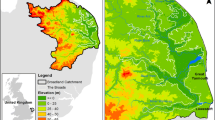Abstract
Coastal flooding within Great Lakes communities poses severe threats to ecosystem and economic sustainability. Accurate and efficient flood predictions could provide critical advanced warnings and improve local resilience. Three types of modeling approaches, including the Bathtub Method (BTM), Extended Hydrodynamic model (EXT), and Total Water Level (TWL) approach, were evaluated for a flood event in the Great Lakes. These studied modeling approaches have successfully replicated water levels at four nearshore gauge stations in the lake, indicating a reliable starting point for coastal flood simulations. Comparisons were made between simulations of maximum flood extent using different methods in three typical high flooding risk areas, including an open-bay area, along coasts of drowned-river-mouth (estuaries) lakes, and a section of shoreline with heavy infrastructural facilities. In addition, aerial photos from news reports and synthetic aperture radar (SAR) data were analyzed in this study to provide observed information for the studied flooding events. According to the results, BTM and EXT were consistent in simulating flood extents for various types of coastal areas, while the TWL was limited in predicting flood propagation into inland areas, particularly in the coasts of river-mouth lakes. Despite slightly overestimating the flood extent in disconnected low-lying areas, the BTM can still serve as a cost-effective tool to provide preliminary flood simulations for the Great Lakes region. We further discuss operational perspectives of using BTM, EXT, and TWL for coastal flood modeling. The results of this study could be used to improve the guidance of coastal management by determining efficient and accurate approaches for coastal flood predictions.













Similar content being viewed by others
Data availability
The datasets analyzed during the current study are available from the corresponding author on reasonable request.
References
Anderson EJ, Mann GE (2021) A high-amplitude atmospheric inertia–gravity wave-induced meteotsunami in Lake Michigan. Nat Hazards 106:1489–1501. https://doi.org/10.1007/s11069-020-04195-2
Anderson EJ, Fujisaki-Manome A, Kessler J et al (2018) Ice Forecasting in the Next-Generation Great Lakes Operational Forecast System (GLOFS). J Mar Sci Eng 6:123. https://doi.org/10.3390/jmse6040123
Bates PD, De Roo APJ (2000) A simple raster-based model for flood inundation simulation. J Hydrol 236:54–77. https://doi.org/10.1016/S0022-1694(00)00278-X
Brown JT (2016) Introduction to FEMA’s National Flood Insurance Program (NFIP). Congressional Research Service Washington
Carter E, Steinschneider S (2018) Hydroclimatological drivers of extreme floods on lake ontario. Water Resour Res 54:4461–4478. https://doi.org/10.1029/2018WR022908
Castrucci L, Tahvildari N (2018) Modeling the impacts of sea level rise on storm surge inundation in flood-prone urban areas of Hampton roads, Virginia. Mar Technol Soc J 52:92–105. https://doi.org/10.4031/MTSJ.52.2.11
Chen C, Liu H, Beardsley RC (2003) An unstructured grid, Finite-Volume, Three-Dimensional, Primitive equations ocean model: Application to Coastal Ocean and Estuaries. J Atmos Oceanic Technol 20:159–186. https://doi.org/10.1175/1520-0426(2003)020%3c0159:AUGFVT%3e2.0.CO;2
Chen C, Qi J, Li C, et al (2008) Complexity of the flooding/drying process in an estuarine tidal-creek salt-marsh system: An application of FVCOM. J Geophys Res Oceans 113. https://doi.org/10.1029/2007JC004328
De Goede ED (2020) Historical overview of 2D and 3D hydrodynamic modelling of shallow water flows in the Netherlands. Ocean Dyn 70:521–539. https://doi.org/10.1007/s10236-019-01336-5
Deltares (2016) 3D/2D modelling suite for integral water solutions - Delft3D User Manual
Didier D, Baudry J, Bernatchez P et al (2019) Multihazard simulation for coastal flood mapping: Bathtub versus numerical modelling in an open estuary, Eastern Canada. J Flood Risk Manage 12:e12505. https://doi.org/10.1111/jfr3.12505
Esteban MD, Martínez-Orozco JM, Fernández B (2020) Analysis of the Approaches for the Modelling of Sea-level Rise due to Climate Change: Galician Coast (Spain). J Coastal Res 95:1078–1082. https://doi.org/10.2112/SI95-210.1
Feng Z, Leung LR, Hagos S et al (2016) More frequent intense and long-lived storms dominate the springtime trend in central US rainfall. Nat Commun 7:13429. https://doi.org/10.1038/ncomms13429
Fuller K, Canada CE, Shear H et al (1995) The Great Lakes: An Environmental Atlas and Resource Book. Environmental Protection Agency, Great Lakes National Program Office, U.S
Gallien TW (2016) Validated coastal flood modeling at Imperial Beach, California: Comparing total water level, empirical and numerical overtopping methodologies. Coast Eng 111:95–104. https://doi.org/10.1016/j.coastaleng.2016.01.014
Gronewold AD, Rood RB (2019) Recent water level changes across Earth’s largest lake system and implications for future variability. J Great Lakes Res 45:1–3. https://doi.org/10.1016/j.jglr.2018.10.012
Holman RA (1986) Extreme value statistics for wave run-up on a natural beach. Coast Eng 9:527–544. https://doi.org/10.1016/0378-3839(86)90002-5
Hong Y, Xuan Do H, Kessler J et al (2022) Evaluation of gridded precipitation datasets over international basins and large lakes. J Hydrol 607:127507. https://doi.org/10.1016/j.jhydrol.2022.127507
Huang C, Anderson E, Liu Y et al (2022) Evaluating essential processes and forecast requirements for meteotsunami-induced coastal flooding. Nat Hazards 110:1693–1718. https://doi.org/10.1007/s11069-021-05007-x
Jalili Pirani F, Najafi MR (2020) Recent trends in individual and multivariate compound flood drivers in Canada’s coasts. Water Resour Res 56:e2020WR027785. https://doi.org/10.1029/2020WR027785
Janin JM, Lepeintre F, Péchon P (1992) TELEMAC-3D: A finite element code to solve 3D free surface flow problems. In: Partridge PW (ed) Computer Modelling of Seas and Coastal Regions. Springer, Netherlands, Dordrecht, pp 489–506
Kelley JGW, Chen Y, Anderson EJ, et al (2018) Upgrade of NOS Lake Erie Operational Forecast System (LEOFS) to FVCOM : model development and hindcast skill assessment. https://doi.org/10.7289/V5/TM-NOS-CS-40
Kumbier K, Carvalho RC, Vafeidis AT, Woodroffe CD (2019) Comparing static and dynamic flood models in estuarine environments: A case study from south-east Australia. Mar Freshw Res 70:781–793. https://doi.org/10.1071/MF18239
Li N, Roeber V, Yamazaki Y et al (2014) Integration of coastal inundation modeling from storm tides to individual waves. Ocean Model 83:26–42. https://doi.org/10.1016/j.ocemod.2014.08.005
NOAA (2020) April 29–30th, 2020 Heavy Rain and Lakeshore Flooding. https://www.weather.gov/grr/04302020_HeavyRain_LakeshoreFlooding. Accessed 10 Sep 2023
Orton PM, Conticello FR, Cioffi F et al (2020) Flood hazard assessment from storm tides, rain and sea level rise for a tidal river estuary. Nat Hazards 102:729–757. https://doi.org/10.1007/s11069-018-3251-x
Pampell-Manis A, Horrillo J, Figlus J (2016) Estimating tsunami inundation from hurricane storm surge predictions along the U.S. gulf coast. Ocean Dyn 66:1005–1024. https://doi.org/10.1007/s10236-016-0966-7
Pandey S, Rao AD, Haldar R (2021) Modeling of Coastal Inundation in Response to a Tropical Cyclone Using a Coupled Hydraulic HEC-RAS and ADCIRC Model. J Geophys Res Oceans 126:e2020JC016810. https://doi.org/10.1029/2020JC016810
Ramirez JA, Lichter M, Coulthard TJ, Skinner C (2016) Hyper-resolution mapping of regional storm surge and tide flooding: comparison of static and dynamic models. Nat Hazards 82:571–590. https://doi.org/10.1007/s11069-016-2198-z
Roelvink D, Reniers A, Van Dongeren A, et al (2010) XBeach model description and manual. Unesco-IHE Institute for Water Education, Deltares and Delft University of Tecnhology Report June 21:2010
Roth RE, Hart D, Mead R, Quinn C (2017) Wireframing for interactive & web-based geographic visualization: designing the NOAA Lake Level Viewer. Cartogr Geogr Inf Sci 44:338–357. https://doi.org/10.1080/15230406.2016.1171166
Saharia AM, Zhu Z, Atkinson JF (2021) Compound flooding from lake seiche and river flow in a freshwater coastal river. J Hydrol 603:126969. https://doi.org/10.1016/j.jhydrol.2021.126969
Seenath A, Wilson M, Miller K (2016) Hydrodynamic versus GIS modelling for coastal flood vulnerability assessment: Which is better for guiding coastal management? Ocean Coast Manag 120:99–109. https://doi.org/10.1016/j.ocecoaman.2015.11.019
Semmendinger K, Foley J, Steinschneider S (2021) A Probabilistic, Parcel-Level inundation prediction tool for medium-range flood forecasting in large lake systems. J Am Water Resour Assoc 57:57–74. https://doi.org/10.1111/1752-1688.12893
Shen X, Anagnostou EN, Allen GH et al (2019a) Near-real-time non-obstructed flood inundation mapping using synthetic aperture radar. Remote Sens Environ 221:302–315. https://doi.org/10.1016/j.rse.2018.11.008
Shen X, Wang D, Mao K et al (2019b) Inundation extent mapping by synthetic aperture radar: A Review. Remote Sensing 11:879. https://doi.org/10.3390/rs11070879
Steinschneider S, Styler A, Stedman R, Austerman M (2019) A rapid response survey to characterize the impacts of the 2017 high water event on lake ontario. JAWRA J Am Water Res Assoc 55:1065–1079. https://doi.org/10.1111/1752-1688.12750
Tolman HL (2009) User manual and system documentation of WAVEWATCH III TM version 3.14. Technical note, MMAB Contribution 276
USACE (2023) Water Level Data. https://www.lre.usace.army.mil/Missions/Great-Lakes-Information/Great-Lakes-Information-2/Water-Level-Data/. Accessed 10 Sep 2023
van der Westhuysen AJ, Padilla-Hernandez R, Santos P, et al (2013) Development and validation of the Nearshore Wave Prediction System. AMS
Vilibić I, Rabinovich AB, Anderson EJ (2021) Special issue on the global perspective on meteotsunami science: editorial. Nat Hazards 106:1087–1104. https://doi.org/10.1007/s11069-021-04679-9
Williams LL, Lück-Vogel M (2020) Comparative assessment of the GIS based bathtub model and an enhanced bathtub model for coastal inundation. J Coast Conserv 24:23. https://doi.org/10.1007/s11852-020-00735-x
Williamson J (2014) The inland seas of North America: and, The natural and industrial productions of Canada with the real foundations for its future prosperity. J. Duff, Kingston
Yang Q, Shen X, Anagnostou EN et al (2021) A high-resolution flood inundation archive (2016–the Present) from Sentinel-1 SAR Imagery over CONUS. Bull Am Meteor Soc 102:E1064–E1079. https://doi.org/10.1175/BAMS-D-19-0319.1
Zheng Y, Sun H (2020) An integrated approach for the simulation modeling and risk assessment of coastal flooding. Water 12:2076. https://doi.org/10.3390/w12082076
Zijlema M, Stelling G, Smit P (2011) SWASH: An operational public domain code for simulating wave fields and rapidly varied flows in coastal waters. Coast Eng 58:992–1012. https://doi.org/10.1016/j.coastaleng.2011.05.015
Acknowledgements
The study was supported by funding awarded to the Cooperative Institute for Great Lakes Research (CIGLR) through the U.S. National Oceanic and Atmospheric Administration (NOAA) Cooperative Agreement with the University of Michigan. The CIGLR contribution number is 1150. This is GLERL Contribution No. 869600.
Author information
Authors and Affiliations
Corresponding author
Ethics declarations
Conflict of interest
The authors declare that they have no conflict of interest.
Additional information
Responsible Editor: Yasumasa Miyazawa
Topical Collection on the 12th International Workshop on Modeling the Ocean (IWMO), Ann Arbor, USA, 25 June – 1 July 2022
Supplementary Information
Below is the link to the electronic supplementary material.
Rights and permissions
Springer Nature or its licensor (e.g. a society or other partner) holds exclusive rights to this article under a publishing agreement with the author(s) or other rightsholder(s); author self-archiving of the accepted manuscript version of this article is solely governed by the terms of such publishing agreement and applicable law.
About this article
Cite this article
Hong, Y., Kessler, J., Titze, D. et al. Towards efficient coastal flood modeling: A comparative assessment of bathtub, extended hydrodynamic, and total water level approaches. Ocean Dynamics 74, 391–405 (2024). https://doi.org/10.1007/s10236-024-01610-1
Received:
Accepted:
Published:
Issue Date:
DOI: https://doi.org/10.1007/s10236-024-01610-1




